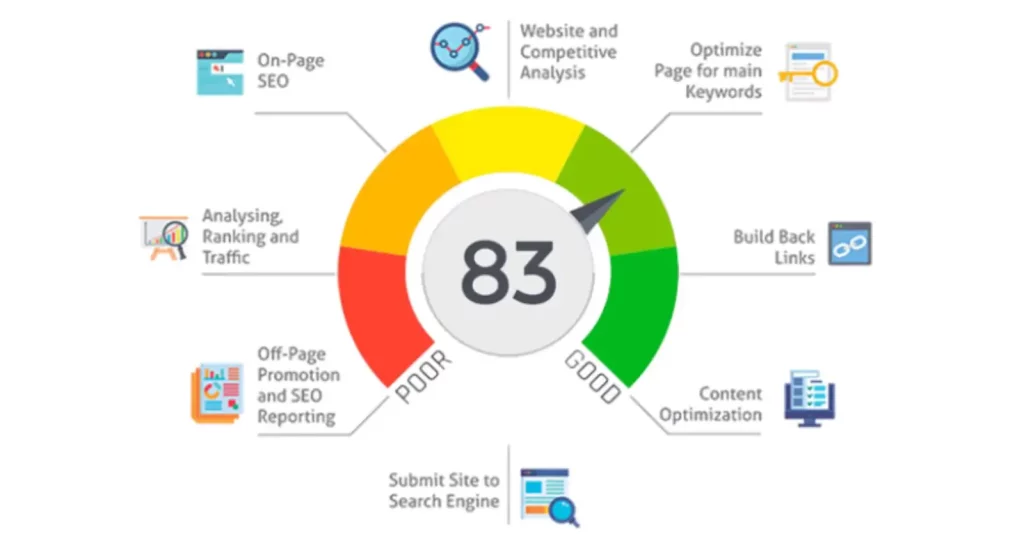Your SEO report card offers crucial information about the types of content that are profitable and the types of content that do not perform well. Let us find out and learn how to comprehend the SEO statistics for your website.
There’s a reason why Search Engine Optimization (SEO), as per 82 percent of marketing executives, is considered to be among the most effective internet advertising available techniques nowadays.
By facilitating organic internet searches, Search engine optimization empowers your best consumers to discover you. Consequently, more transactions are accomplished, and brand awareness has never been better.
SEO Report Card
An SEO report card can provide you with a specific visual assessment regarding where you’re at right now and what you’re able to change to enhance your website looking ahead.
It can be challenging to rank among the top listing of search results given the fact that there are millions of online websites. You may learn what is keeping your website from getting to the top of the page with the help of an SEO report.
SEO’s Significance in Digital Marketing

Since your company will miss the opportunity to capitalize on a multitude of growth opportunities if customers are searching for what you provide, but your web page doesn’t come up, SEO is essential. People will be uninformed of whatever digital presence you might well have.
Due to the fact that Search engine optimization is among a handful of marketing techniques that may connect to customers who are actively searching for you, it provides a considerable return on investment.
While social media, as well as outside links to your webpage, may contribute to a portion of the traffic that your website receives, searches on search engines such as Google, Bing, and Yahoo account for over 95 percent of all website visitors.
Individuals who find your web page using a search engine are a specialized audience and are typically eager for the goods and services that you offer. Your visibility improves, your firm grows, and your recognition booms when relevant visitors visit your internet presence.
What Comes with Your SEO Report Card?
These frequently contain the most essential SEO statistics, such as backlinks, the technical status of the website, click-through rates, keyword ranks, organic visitors, revenues, and so on.
An SEO report’s primary goal is to demonstrate to your user how beneficial your SEO campaign proved to be and how your SEO technique is impacting the performance of their webpage across all aspects.
You will receive your results assessed and delivered to you if you employ a service, much like software testing. However, you can make your personalized report card utilizing the indicators that obtained the highest scores.
What metrics should an SEO Report Card cover?
Congratulations! You’re on the right path to improving your website’s SEO by seeking an SEO report card. But what should you look for in an SEO report card, and how do you interpret the data it provides?
First, let’s talk about what metrics should be covered in an SEO report card. Ideally, your report card should cover a range of essential SEO factors, such as website speed, mobile-friendliness, page load times, meta descriptions, title tags, and more.
Now, once you’ve got your SEO report card, how do you make sense of all that data? Well, first off, don’t let yourself get overwhelmed. Taking a step back and focusing on the big picture is essential. Are there any glaring issues that jump out at you? Are there areas where your website is performing well and others that need improvement?
How to interpret the data in an SEO Report Card?
When interpreting your SEO report card, there are a few key things to keep in mind. First, look for trends over time. Is your website’s performance improving or declining? If you notice a downward trend, it’s essential to take action and identify the root cause of the issue.
How to identify areas for improvement in your website’s SEO?
Finally, one of the most valuable things an SEO report card can do for you is identify areas for improvement in your website’s SEO. Maybe your website lacks quality backlinks, or your meta descriptions need work. By identifying these areas for improvement, you can take action and make changes that will have a tangible impact on your website’s search engine rankings.
So, there you have it – a quick overview of what to look for in an SEO report card, how to interpret the data, and how to identify areas for improvement. Keep these tips in mind, and you’ll be well on your way to optimizing your website’s SEO.
Current Position for Keywords

This is an essential thing to start doing if you aren’t currently integrating keywords into your website. Using keywords with excellent search engine rankings assists search engines in linking your webpage to a keyword-specific search query.
While looking for keywords, there are many available resources, such as Google’s keyword searching tool. These tools present the most effective and relevant keywords for your website.
When you verify your keyword ranking, it will let you know how many other websites are employing the exact keywords that you do, as well as where you are on the roster of competitors. This information is utilized to alter your keywords in order to become more focused while still appealing to your targeted audience.
Link Enhancement

Your internal and external link score is another element that should be on your SEO report card. Your website’s links must be functioning and legitimate in order to direct users there and aside from it. To ensure there are no broken links, take it upon yourself to constantly monitor your connections.
Search engines blame you for having destroyed links since they assume you are untrustworthy and decrease your rankings in search engine scores as a consequence. It is not acceptable to direct people to an internet address or webpage that is no longer functional.
On-Page Assessment

Setting initial metrics includes undertaking an assessment of your entire on-page. Check that all of the essential SEO points are being addressed on each page of your website. Are you using headers and titles on your internet pages? Take your time combing through every site and updating them if they don’t.
This can take some time, based on how many sections are on your website. Concentrate on just a few pages and conduct search engine optimization on them during the initial 20 minutes of each week.
Check your pictures to verify if they have descriptions and alternate tags and are a perfect size. This underutilized technique raises your website’s ranking score.
However, it can, at times, be ignored. Make sure your links are functioning by performing the previously identified analysis. Last, take a quick look to see if there are any unusual or out-of-place things.
Current Indexing

Regularly indexing your fresh content through Google is a crucial added step. The search engine is unlikely to know that your new pages exist if the pages are restricted, unregistered, or not indexed.
How to Get a Free SEO Report Card?
We’ve discussed what to look for in an SEO report card, but where do you get one? Fear not, my friend, because plenty of online tools can generate a free SEO report card for you in a matter of minutes.
What are the best free tools for generating an SEO report card?
First, let’s talk about some of the best free tools for generating an SEO report card. One popular option is SEMrush, which offers a comprehensive report card that covers everything from keyword rankings to site speed. Another great tool is Ahrefs, which provides an SEO report card and gives insights into your competitors’ SEO strategies.
If you’re looking for a free option, there are plenty of those too. Moz offers a free version of its SEO tool, which provides a primary report card that covers on-page optimization, link building, and keyword analysis. Another free tool to consider is Woorank, which provides a report card that covers everything from mobile-friendliness to social media engagement.
How to generate an SEO report card using Google Analytics and Search Console
But what if you’re already using Google Analytics or Google Search Console? Good news – both tools offer the ability to generate an SEO report card for your website. In Google Analytics, simply navigate to the Acquisition > Search Console > Landing Pages section to see a breakdown of your top landing pages and their SEO performance. And in Google Search Console, head to the Performance tab to see a report card that covers everything from clicks to impressions to the average position.
So there you have it – a few different options for generating a free SEO report card. Try out a few different tools and see which one works best for you. And remember, the key is not just to generate a report card but to use the insights it provides to improve your website’s SEO performance.
What Should Grades In SEO Be Included On Your Report Card?
Your overall internet presence is boosted by Search engine optimization, which is how it works the best. Following an audit, you may evaluate what is boosting and what is reducing your online visibility. What does that mean precisely, then?
You must, at the absolute least, pay attention to the following three main SEO aspects:
Technical SEO: The sections of your website involved with code optimizations and adequate site layout
On-page SEO: Including the correct targeted keywords in the content, utilizing markups, and writing excellent page names and descriptions.
Off-page SEO: Online activities that impact your website’s rankings but take place elsewhere on the web.
In other terms, the SEO report card must offer a thorough overview.
What are some common mistakes to avoid when interpreting an SEO report card?
Congratulations! You have successfully generated your SEO report card and identified areas for improvement on your website. Now it’s time to take action and optimize your website for search engines. But before diving in headfirst, you must know what mistakes to avoid.
1- First, discuss common mistakes when interpreting an SEO report card. One of the biggest mistakes people make is focusing solely on one metric, such as keyword rankings or page speed, and ignoring the bigger picture. It’s essential to look at all the metrics and data together to understand your website’s SEO performance comprehensively.
2- Another mistake to avoid is needing to understand the context of the data. For example, if your bounce rate is high, it could be due to various factors, such as slow loading times or irrelevant content. It’s essential to dig deeper and figure out the root cause of the issue before jumping to conclusions.
3- Now, let’s move on to common mistakes when optimizing your website for search engines. One of the biggest things that could be improved is stuffing your content with keywords. While it’s essential to include relevant keywords, using them can help your SEO performance. Use keywords that make sense for your content naturally and organically.
4- Another mistake is paying attention to the user experience. While optimizing your website for search engines is essential, you also need to ensure it is user-friendly and easy to navigate. If your website is easy to use or has a good design, it can harm your SEO performance.
5- Last, it’s important to avoid black hat SEO tactics that can harm your website’s ranking. Black hat SEO tactics include buying backlinks or keyword stuffing, which can result in penalties from search engines. Stick to ethical and white-hat SEO tactics to ensure long-term success.
Now that you know what mistakes to avoid, it’s time to optimize your website for search engines. Remember that SEO is a long-term process and takes time to see results. By following best practices and avoiding common mistakes, you’ll be on your way to improving your website’s SEO performance and driving more traffic
FAQs
You can quickly determine just how optimized your site is by checking the SEO score, which is shown first. The following items list the number of variables examined and passed, the percentage with cautions linked to them, and the number that ended in failure. If any tests were run with inconclusive outcomes, they will appear in the list box.
How do I find out where I stand in SEO? You can use various online tools, such as the Seobility Ranking Checking, to verify your ranks. You only need to type in your web address and the search keyword you would like to check. The software will present the 100 Best Websites for this term, along with the placement of your domain.
The SEO Score measures how well your site’s structural and user-facing components enable search engine optimization, which results in improved search engine results and website visitors.
To write an SEO report, first, thoroughly analyze the website’s on-page and off-page SEO factors. Next, use a tool to track the website’s rankings and traffic data. Finally, compile the data and provide recommendations for improvement.
An SEO analysis report is a comprehensive report that analyzes a website’s SEO factors, including on-page and off-page factors, rankings, traffic data, and more. It is used to identify areas for improvement and create a plan for optimizing a website’s SEO.
SEO ranking refers to a website’s position in search engine results pages (SERPs) for specific keywords or phrases. A higher ranking means the website appears closer to the top of the search results, resulting in more visibility and potentially more traffic.
An SEO report typically summarizes the website’s current SEO status, including rankings, traffic data, and key metrics. It may also include a detailed analysis of on-page and off-page SEO factors and recommendations for improvement.
To write SEO in 4 easy steps, conduct keyword research to identify relevant keywords and phrases. Next, optimize your website’s on-page elements, including title tags, meta descriptions, and content. Then, build high-quality backlinks to your website. Finally, track your results and make adjustments as needed.
SEO writing samples refer to examples of written content optimized for search engines. These samples demonstrate how to incorporate relevant keywords and phrases into high-quality content that is engaging and informative for readers.
Conclusion:
Now that you know the criteria to evaluate your SEO performance, you should begin everyday efforts to raise your SEO ranking. Examine your site’s crawling; your site’s both internal and external links, the use of titles and picture tags, and its online presence.
You should also look at the keywords and their ratings. Even though it may appear to be a lot, investing only a little time each week in these tasks will significantly impact your company’s SEO report card. Your website will start to receive more attention, there will be more eligible customers, and ultimately and there will be additional sales.
Also Explore:
Complete On-page SEO checklist

Leave a Reply